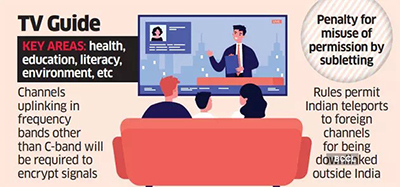Date: 11/11/2022
Relevance: GS-3: Internal security: challenges to internal security through communication networks, role of media and social networking sites in internal security challenges.
Key Phrases: Public service broadcast, Guidelines for Uplinking and Downlinking of Satellite Television Channels in India, 2022, Uplinking, Downlinking, Compliance issues, TV channel broadcasting rules.
Context:
- Recently the Union Cabinet approved new guidelines for TV channels which mandate the channels to broadcast content on themes of national importance and socially relevant issues for at least 30 minutes every day.
Key Highlights
- The Guidelines called ‘Guidelines for Uplinking and Downlinking of Satellite Television Channels in India, 2022’ point out that as airwaves and frequencies are public property and need to be used in the best interest of society.
- A company with permission to operate in India, barring foreign channels, will have to air content in the service of the public.
- The new guidelines have been amended after a gap of 11 years and are important in this time of polarizing opinions, heated debates and narrow targeting of ideas.
Do you know?
- According to the Information and Broadcasting Ministry, presently there are more than 870 channels operating in the country.
- According to a FICCI-EY report, television subscriptions are estimated at about 178 million in 2021 and will add another 42 million by 2025.
How will the public service broadcasting take place?
- Under the guidelines all TV channels, including private channels will undertake public service broadcasting for a minimum period of 30 minutes in a day on themes of national importance and of social relevance.
- It will focus on 8 “themes of national importance and of social
relevance”on which a lot more awareness is necessary such as-
- Education and spread of literacy.
- Agriculture and rural development.
- Health and family welfare.
- Science and technology.
- Welfare of women and weaker sections of society.
- Protection of the environment.
- Cultural heritage and national integration.
- Although specific advisory on the date of its commencement will come later and the channels will be given some time to conceptualize and create such content.
What are the other significant provisions?
- The guidelines span a range of subjects including uplinking and downlinking, hiring and purchase of broadcast equipment, changes in name and logo, etc.
- Channels uplinking in frequency bands other than C-band must encrypt their signals.
- Uplinking and downlinking shall be subject to clearance and approval by the Ministry of Home Affairs and other such designated authorities.
- The new guidelines allow a news agency to get permission for five years instead of the current one year.
- The penalty clauses have been rationalized, and separate sets of penalties have been proposed for different types of contraventions as against the uniform penalty that is applicable currently.
How will compliance be ensured?
- Once the guidelines are implemented, the Ministry will monitor the channels for the broadcast of this content.
- In case of non-compliance, the ministry will take actions based on the specific guidelines issued from time to time and on a case to case basis.
- Some specific channel categories such as sports channels might get
exemption time being due to feasibility of broadcasting such content on
their platforms.
- The exemption may also apply to wildlife channels and foreign channels.
Issues and challenges
- Unfair to the Broadcasters:
- The broadcasters are not happy as they have paid hefty fees for their use and any binding guidelines that adversely impact their commercial interests are not fair towards them.
- Discretion of channels on content creation:
- No set of modules and rules on the format of fulfilling the obligations and left to the discretion of Channels which might create chaotic issues.
- It could be misused for vested propaganda and political gains.
- There is no clarity yet on compensation norms and who is going to pay the expenditure for the public service component on TV.
Conclusion and way forward
- The Government has done away with the requirement to seek permission for live telecast of events; only prior registration of events will be necessary for live telecast.
- The new policy eases compliance for TV channels in various areas.
- Broadcast companies will be allowed to uplink foreign channels from Indian teleports, which would create employment opportunities and make India a teleport hub for other countries.
- Foreign channels are expected to show greater interest in using Indian teleports which will help India become a hub of teleport uplinking on the lines of Singapore.
- Public service broadcast is a good idea in a diverse country and the guidelines are intended with the right intent.
- But there are certain challenges as well therefore the need of the hour is to take all the stakeholders in confidence, take their suggestions and then move forward.
Source: The Hindu
Mains Question:
Q. What do you understand by Public service broadcasts? Public service broadcast could be the catalyst to the national integration in a diverse country like India, Discuss. (250 words).








